PIX/ASA 7.x and above: PIX-to-PIX VPN Tunnel Configuration Example
Available Languages
Contents
Introduction
This document describes the procedure to configure VPN tunnels between two PIX Firewalls using Cisco Adaptive Security Device Manager (ASDM). ASDM is an application-based configuration tool designed to help you set up, configure, and monitor your PIX Firewall with a GUI. PIX Firewalls are placed at two different sites.
A tunnel is formed using IPsec. IPsec is a combination of open standards that provide data confidentiality, data integrity, and data origin authentication between IPsec peers.
Note: In PIX 7.1 and later, the sysopt connection permit-ipsec command is changed to sysopt connection permit-vpn. This command allows traffic that enters the security appliance through a VPN tunnel and is then decrypted, to bypass interface access lists. Group policy and per-user authorization access lists still apply to the traffic. In order to disable this feature, use the no form of this command. This command is not visible in the CLI configuration.
Refer to PIX 6.x: Simple PIX-to-PIX VPN Tunnel Configuration Example in order to learn more about the same scenario where the Cisco PIX Security Appliance runs software version 6.x.
Prerequisites
Requirements
There are no specific requirements for this document.
Components Used
The information in this document specifies that this peer initiates the first proprietary exchange in order to determine the appropriate peer to which to connect.
-
Cisco PIX 500 Series Security Appliance with version 7.x and later
-
ASDM version 5.x.and later
Note: Refer to Allowing HTTPS Access for ASDM in order to allow the ASA to be configured by the ASDM.
Note: The ASA 5500 series version 7.x/8.x runs the same software seen in PIX version 7.x/8.x. The configurations in this document are applicable to both product lines.
The information in this document was created from the devices in a specific lab environment. All of the devices used in this document started with a cleared (default) configuration. If your network is live, make sure that you understand the potential impact of any command.
Network Diagram
This document uses this network setup:
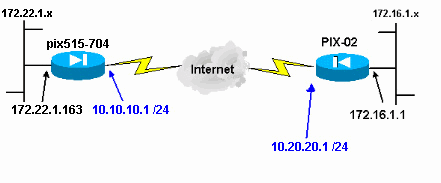
Conventions
Refer to the Cisco Technical Tips Conventions for more information on document conventions.
Background Information
IPsec negotiation can be broken down into five steps, and includes two Internet Key Exchange (IKE) phases.
-
An IPsec tunnel is initiated by interesting traffic. Traffic is considered interesting when it travels between the IPsec peers.
-
In IKE Phase 1, the IPsec peers negotiate the established IKE Security Association (SA) policy. Once the peers are authenticated, a secure tunnel is created using Internet Security Association and Key Management Protocol (ISAKMP).
-
In IKE Phase 2, the IPsec peers use the authenticated and secure tunnel to negotiate IPsec SA transforms. The negotiation of the shared policy determines how the IPsec tunnel is established.
-
The IPsec tunnel is created and data is transferred between the IPsec peers based on the IPsec parameters configured in the IPsec transform sets.
-
The IPsec tunnel terminates when the IPsec SAs are deleted or when their lifetime expires.
Note: IPsec negotiation between the two PIXes fails if the SAs on both of the IKE phases do not match on the peers.
Configuration
ASDM Configuration
Complete these steps:
-
Open your browser and type https://<Inside_IP_Address_of_PIX> to access the ASDM on the PIX.
Be sure to authorize any warnings your browser gives you related to SSL certificate authenticity. The default username and password are both blank.
The PIX presents this window to allow the download of the ASDM application. This example loads the application onto the local computer and does not run in a Java applet.
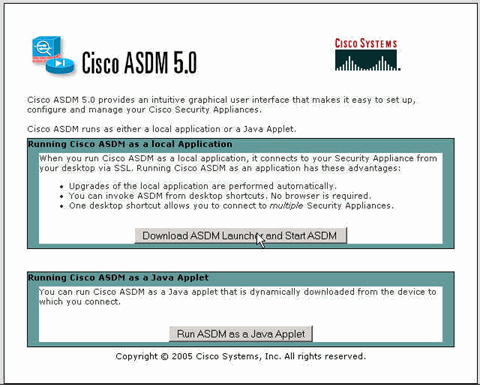
-
Click Download ASDM Launcher and Start ASDM to download the installer for the ASDM application.
-
Once the ASDM Launcher downloads, follow the prompts in order to install the software and run the Cisco ASDM Launcher.
-
Enter the IP address for the interface you configured with the http - command and a username and password if you specified one.
This example uses the default blank username and password.
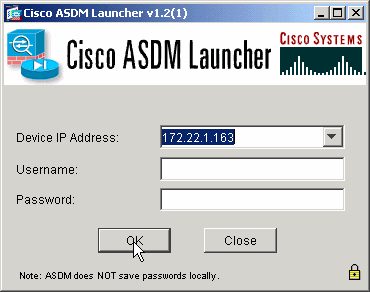
-
Run the VPN Wizard once the ASDM application connects to the PIX.
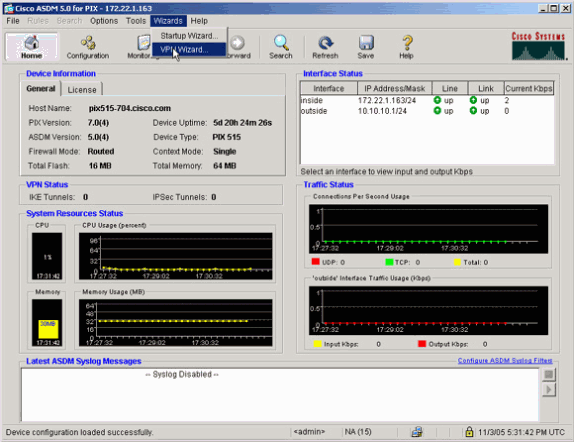
-
Choose the Site-to-Site VPN tunnel type.
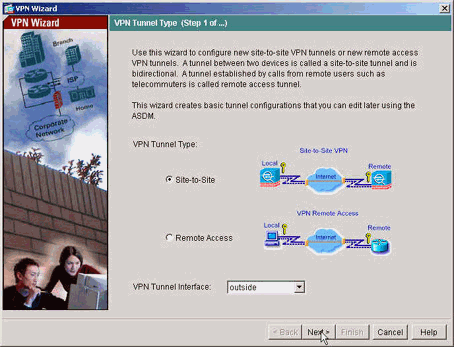
-
Specify the outside IP address of the remote peer. Enter the authentication information to use (pre-shared key in this example).
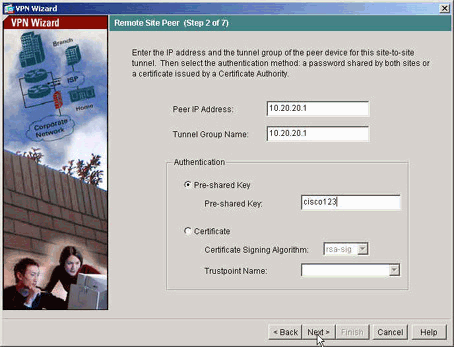
-
Specify the attributes to use for IKE, also known as "Phase 1". These attributes must be the same on both sides of the tunnel.
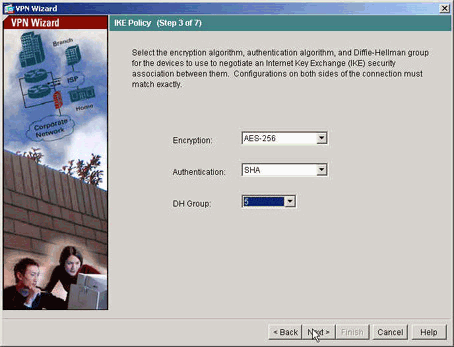
-
Specify the attributes to use for IPsec, also known as "Phase 2". These attributes must match on both sides.
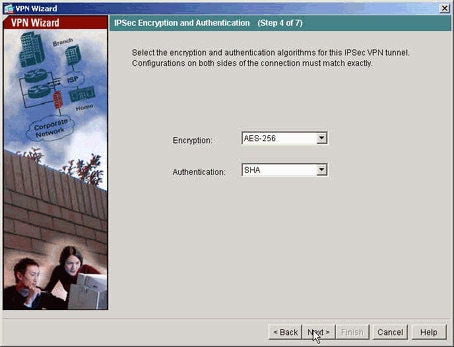
-
Specify the hosts whose traffic should be allowed to pass through the VPN tunnel. In this step, the hosts local to pix515-704 are specified.
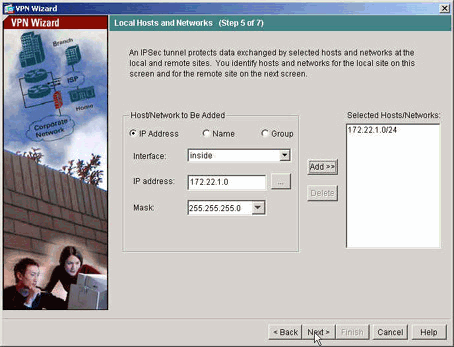
-
The hosts and networks on the remote side of the tunnel are specified.
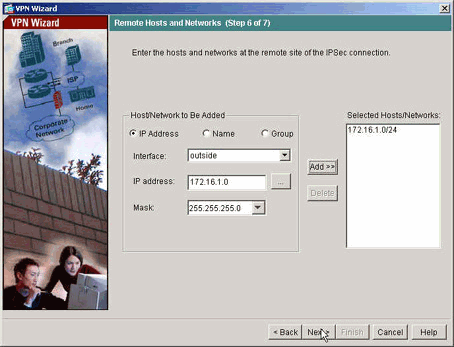
-
The attributes defined by the VPN Wizard are displayed in this summary. Double check the configuration and click Finish when you are satisfied the settings are correct.
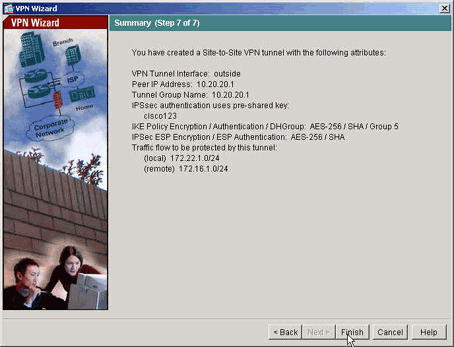
PIX CLI Configuration
| pix515-704 |
|---|
pixfirewall#show run : Saved PIX Version 7.1(1) ! hostname pixfirewall domain-name default.domain.invalid enable password 8Ry2YjIyt7RRXU24 encrypted names ! interface Ethernet0 nameif outside security-level 0 ip address 10.10.10.1 255.255.255.0 !--- Configure the outside interface. ! interface Ethernet1 nameif inside security-level 100 ip address 172.22.1.163 255.255.255.0 !--- Configure the inside interface. ! !-- Output suppressed ! passwd 2KFQnbNIdI.2KYOU encrypted ftp mode passive dns server-group DefaultDNS domain-name default.domain.invalid access-list inside_nat0_outbound extended permit ip 172.22.1.0 255.255.255.0 172 .16.1.0 255.255.255.0 !--- This access list (inside_nat0_outbound) is used with the nat zero command. !--- This prevents traffic which matches the access list from undergoing !--- network address translation (NAT). The traffic specified by this ACL is !--- traffic that is to be encrypted and !--- sent across the VPN tunnel. This ACL is intentionally !--- the same as (outside_cryptomap_20). !--- Two separate access lists should always be used in this configuration. access-list outside_cryptomap_20 extended permit ip 172.22.1.0 255.255.255.0 172 .16.1.0 255.255.255.0 !--- This access list (outside_cryptomap_20) is used with the crypto map !--- outside_map to determine which traffic should be encrypted and sent !--- across the tunnel. !--- This ACL is intentionally the same as (inside_nat0_outbound). !--- Two separate access lists should always be used in this configuration. pager lines 24 mtu inside 1500 mtu outside 1500 no failover asdm image flash:/asdm-511.bin !--- Enter this command to specify the location of the ASDM image. asdm history enable arp timeout 14400 nat (inside) 0 access-list inside_nat0_outbound !--- NAT 0 prevents NAT for networks specified in the ACL inside_nat0_outbound. route outside 0.0.0.0 0.0.0.0 10.10.10.2 1 timeout xlate 3:00:00 timeout conn 1:00:00 half-closed 0:10:00 udp 0:02:00 icmp 0:00:02 timeout sunrpc 0:10:00 h323 0:05:00 h225 1:00:00 mgcp 0:05:00 timeout mgcp-pat 0:05:00 sip 0:30:00 sip_media 0:02:00 timeout uauth 0:05:00 absolute http server enable !--- Enter this command in order to enable the HTTPS server for ASDM. http 172.22.1.1 255.255.255.255 inside !--- Identify the IP addresses from which the security appliance !--- accepts HTTPS connections. no snmp-server location no snmp-server contact !--- PHASE 2 CONFIGURATION ---! !--- The encryption types for Phase 2 are defined here. crypto ipsec transform-set ESP-AES-256-SHA esp-aes-256 esp-sha-hmac !--- Define the transform set for Phase 2. crypto map outside_map 20 match address outside_cryptomap_20 !--- Define which traffic should be sent to the IPsec peer. crypto map outside_map 20 set peer 10.20.20.1 !--- Sets the IPsec peer crypto map outside_map 20 set transform-set ESP-AES-256-SHA !--- Sets the IPsec transform set "ESP-AES-256-SHA" !--- to be used with the crypto map entry "outside_map". crypto map outside_map interface outside !--- Specifies the interface to be used with !--- the settings defined in this configuration. !--- PHASE 1 CONFIGURATION ---! !--- This configuration uses isakmp policy 10. !--- Policy 65535 is included in the config by default. !--- The configuration commands here define the Phase !--- 1 policy parameters that are used. isakmp enable outside isakmp policy 10 authentication pre-share isakmp policy 10 encryption aes-256 isakmp policy 10 hash sha isakmp policy 10 group 5 isakmp policy 10 lifetime 86400 isakmp policy 65535 authentication pre-share isakmp policy 65535 encryption 3des isakmp policy 65535 hash sha isakmp policy 65535 group 2 isakmp policy 65535 lifetime 86400 tunnel-group 10.20.20.1 type ipsec-l2l !--- In order to create and manage the database of connection-specific records !--- for ipsec-l2l—IPsec (LAN-to-LAN) tunnels, use the tunnel-group !--- command in global configuration mode. !--- For L2L connections the name of the tunnel group MUST be the IP !--- address of the IPsec peer. tunnel-group 10.20.20.1 ipsec-attributes pre-shared-key * !--- Enter the pre-shared-key in order to configure the authentication method. telnet timeout 5 ssh timeout 5 console timeout 0 ! class-map inspection_default match default-inspection-traffic ! ! policy-map global_policy class inspection_default inspect dns maximum-length 512 inspect ftp inspect h323 h225 inspect h323 ras inspect netbios inspect rsh inspect rtsp inspect skinny inspect esmtp inspect sqlnet inspect sunrpc inspect tftp inspect sip inspect xdmcp ! service-policy global_policy global Cryptochecksum:ecb58c5d8ce805b3610b198c73a3d0cf : end |
| PIX-02 |
|---|
PIX Version 7.1(1) ! hostname pixfirewall domain-name default.domain.invalid enable password 8Ry2YjIyt7RRXU24 encrypted names ! interface Ethernet0 nameif outside security-level 0 ip address 10.20.20.1 255.255.255.0 ! interface Ethernet1 nameif inside security-level 100 ip address 172.16.1.1 255.255.255.0 ! passwd 2KFQnbNIdI.2KYOU encrypted ftp mode passive dns server-group DefaultDNS domain-name default.domain.invalid access-list inside_nat0_outbound extended permit ip 172.16.1.0 255.255.255.0 172 .22.1.0 255.255.255.0 !--- Note that this ACL is a mirror of the inside_nat0_outbound !--- ACL on pix515-704. access-list outside_cryptomap_20 extended permit ip 172.16.1.0 255.255.255.0 172 .22.1.0 255.255.255.0 !--- Note that this ACL is a mirror of the outside_cryptomap_20 !--- ACL on pix515-704. pager lines 24 mtu inside 1500 mtu outside 1500 no failover asdm image flash:/asdm-511.bin no asdm history enable arp timeout 14400 nat (inside) 0 access-list inside_nat0_outbound timeout xlate 3:00:00 timeout conn 1:00:00 half-closed 0:10:00 udp 0:02:00 icmp 0:00:02 timeout sunrpc 0:10:00 h323 0:05:00 h225 1:00:00 mgcp 0:05:00 timeout mgcp-pat 0:05:00 sip 0:30:00 sip_media 0:02:00 timeout uauth 0:05:00 absolute http server enable http 0.0.0.0 0.0.0.0 inside no snmp-server location no snmp-server contact crypto ipsec transform-set ESP-AES-256-SHA esp-aes-256 esp-sha-hmac crypto map outside_map 20 match address outside_cryptomap_20 crypto map outside_map 20 set peer 10.10.10.1 crypto map outside_map 20 set transform-set ESP-AES-256-SHA crypto map outside_map interface outside isakmp enable outside isakmp policy 10 authentication pre-share isakmp policy 10 encryption aes-256 isakmp policy 10 hash sha isakmp policy 10 group 5 isakmp policy 10 lifetime 86400 tunnel-group 10.10.10.1 type ipsec-l2l tunnel-group 10.10.10.1 ipsec-attributes pre-shared-key * telnet timeout 5 ssh timeout 5 console timeout 0 ! class-map inspection_default match default-inspection-traffic ! ! policy-map global_policy class inspection_default inspect dns maximum-length 512 inspect ftp inspect h323 h225 inspect h323 ras inspect netbios inspect rsh inspect rtsp inspect skinny inspect esmtp inspect sqlnet inspect sunrpc inspect tftp inspect sip inspect xdmcp ! service-policy global_policy global Cryptochecksum:6774691244870705f858ad4e9b810874 : end pixfirewall# |
Backup Site-to-Site Tunnel
In order to specify the connection type for the Backup Site-to-Site feature for this crypto map entry, use the crypto map set connection-type command in global configuration mode. Use the no form of this command in order to return to the default setting.
Syntax:
crypto map map-name seq-num set connection-type {answer-only | originate-only | bidirectional}
-
answer-only—This specifies that this peer only responds to inbound IKE connections first during the initial proprietary exchange in order to determine the appropriate peer to which to connect.
-
bidirectional—This specifies that this peer can accept and originate connections based on this crypto map entry. This is the default connection type for all Site-to-Site connections.
-
originate-only—This specifies that this peer initiates the first proprietary exchange in order to determine the appropriate peer to which to connect.
The crypto map set connection-type command specifies the connection types for the Backup LAN-to-LAN feature. It allows multiple backup peers to be specified at one end of the connection. This feature works only between these platforms:
-
Two Cisco ASA 5500 series security appliances
-
Cisco ASA 5500 series security appliance and a Cisco VPN 3000 Concentrator
-
Cisco ASA 5500 series security appliance and a security appliance that runs Cisco PIX Security Appliance Software version 7.0 or later
In order to configure a backup LAN-to-LAN connection, Cisco recommends that you configure one end of the connection as originate-only with the originate-only keyword, and the end with multiple backup peers as answer-only with the answer-only keyword. On the originate-only end, use the crypto map set peer command in order to order the priority of the peers. The originate-only security appliance attempts to negotiate with the first peer in the list. If that peer does not respond, the security appliance works its way down the list until either a peer responds or there are no more peers in the list.
When configured in this way, the originate-only peer initially attempts to establish a proprietary tunnel and negotiate with a peer. Thereafter, either peer can establish a normal LAN-to-LAN connection and data from either end can initiate the tunnel connection.
Note: If you configured VPN with multiple peer IP addresses for a crypto entry, the VPN gets established with the backup peer IP once the primary peer goes down. However, once the primary peer comes back, the VPN does not preempt to the primary IP address. You must manually delete the existing SA in order to reinitiate the VPN negotiation to switch it over to the primary IP address. As the conclusion says, the VPN preempt is not supported in the site-to-site tunnel.
Supported Backup LAN-to-LAN Connection Types
| Remote Side | Central Side |
|---|---|
Originate-Only |
Answer-Only |
Bi-Directional |
Answer-Only |
Bi-Directional |
Bi-Directional |
Example
This example, entered in global configuration mode, configures the crypto map mymap and sets the connection-type to originate-only.
hostname(config)#crypto map outside_map 20 connection-type originate-only
Clear Security Associations (SAs)
In the privilege mode of the PIX, use the following the commands:
-
clear [crypto] ipsec sa—Deletes the active IPsec SAs. The keyword crypto is optional.
-
clear [crypto] isakmp sa—Deletes the active IKE SAs. The keyword crypto is optional.
Verify
Use this section to confirm that your configuration works properly.
The Output Interpreter Tool (registered customers only) (OIT) supports certain show commands. Use the OIT to view an analysis of show command output.
If there is interesting traffic to the peer, the tunnel is established between pix515-704 and PIX-02.
-
View the VPN Status under Home in the ASDM in order to verify the formation of the tunnel.
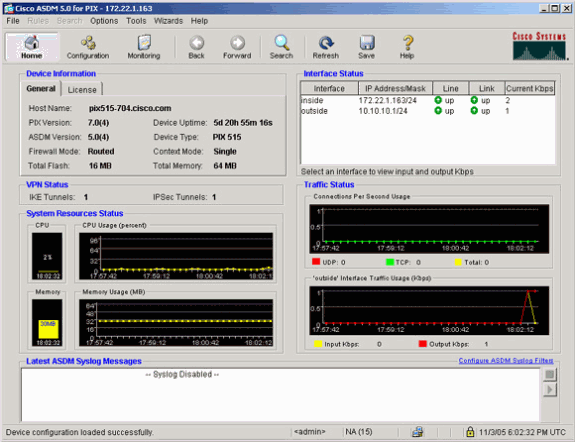
-
Choose Monitoring > VPN > VPN Connection Graphs > IPSec Tunnels in order to verify the details about the tunnel establishment.
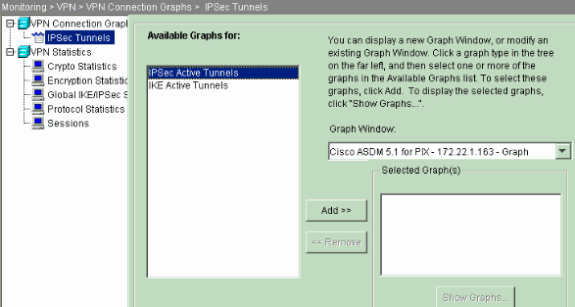
-
Click Add to select the graphs available in order to view in the graph window.
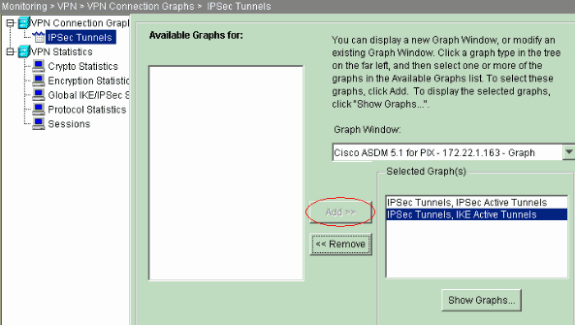
-
Click Show Graphs in order to view the graphs of both IKE and IPsec active tunnels.
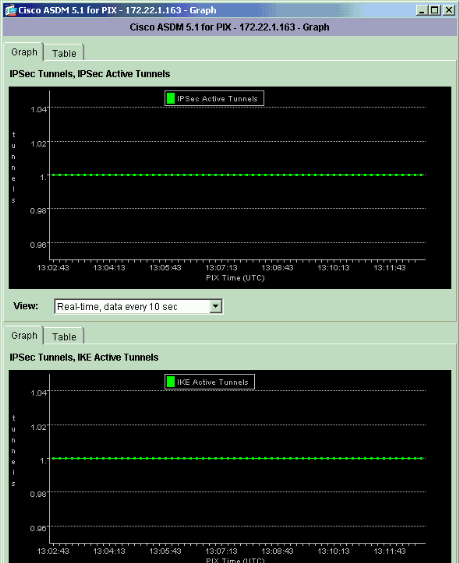
-
Choose Monitoring > VPN > VPN Statistics > Global IKE/IPSec Statistics in order to know about the statistical information of the VPN tunnel.
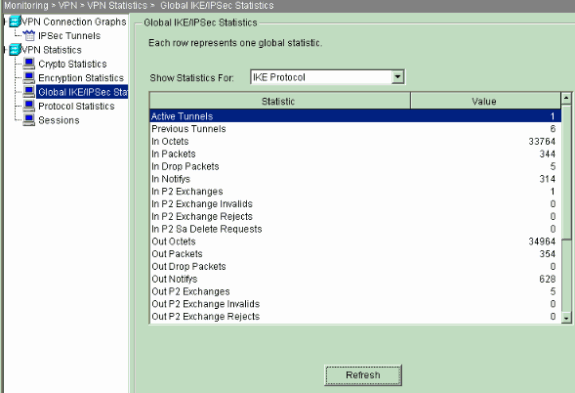
You can also verify the formation of tunnels using CLI. Issue the show crypto isakmp sa command to check the formation of tunnels and issue the show crypto ipsec sa command to observe the number of packets encapsulated, encrypted, and so forth.
| pix515-704 |
|---|
pixfirewall(config)#show crypto isakmp sa
Active SA: 1
Rekey SA: 0 (A tunnel will report 1 Active and 1 Rekey SA during rekey)
Total IKE SA: 1
1 IKE Peer: 10.20.20.1
Type : L2L Role : initiator
Rekey : no State : MM_ACTIVE
|
| pix515-704 |
|---|
pixfirewall(config)#show crypto ipsec sa
interface: outside
Crypto map tag: outside_map, seq num: 20, local addr: 10.10.10.1
access-list outside_cryptomap_20 permit ip 172.22.1.0
255.255.255.0 172.16.1.0 255.255.255.0
local ident (addr/mask/prot/port): (172.22.1.0/255.255.255.0/0/0)
remote ident (addr/mask/prot/port): (172.16.1.0/255.255.255.0/0/0)
current_peer: 10.20.20.1
#pkts encaps: 20, #pkts encrypt: 20, #pkts digest: 20
#pkts decaps: 20, #pkts decrypt: 20, #pkts verify: 20
#pkts compressed: 0, #pkts decompressed: 0
#pkts not compressed: 20, #pkts comp failed: 0, #pkts decomp failed: 0
#send errors: 0, #recv errors: 0
local crypto endpt.: 10.10.10.1, remote crypto endpt.: 10.20.20.1
path mtu 1500, ipsec overhead 76, media mtu 1500
current outbound spi: 44532974
inbound esp sas:
spi: 0xA87AD6FA (2826622714)
transform: esp-aes-256 esp-sha-hmac
in use settings ={L2L, Tunnel, }
slot: 0, conn_id: 1, crypto-map: outside_map
sa timing: remaining key lifetime (kB/sec): (3824998/28246)
IV size: 16 bytes
replay detection support: Y
outbound esp sas:
spi: 0x44532974 (1146300788)
transform: esp-aes-256 esp-sha-hmac
in use settings ={L2L, Tunnel, }
slot: 0, conn_id: 1, crypto-map: outside_map
sa timing: remaining key lifetime (kB/sec): (3824998/28245)
IV size: 16 bytes
replay detection support: Y |
Troubleshoot
PFS
In IPsec negotiations, Perfect Forward Secrecy (PFS) ensures that each new cryptographic key is unrelated to any previous key. Either enable or disable PFS on both the tunnel peers, otherwise the L2L IPsec tunnel is not established in PIX/ASA.
PFS is disabled by default. In order to enable PFS use the pfs command with the enable keyword in group-policy configuration mode. In order to disable PFS, enter the disable keyword.
hostname(config-group-policy)#pfs {enable | disable}
In order to remove the PFS attribute from the running configuration, enter the no form of this command. A group policy can inherit a value for PFS from another group policy. Enter the no form of this command in order to prevent inheriting a value.
hostname(config-group-policy)#no pfs
Management-Access
This section provides information you can use to troubleshoot your configuration.
The inside interface of the PIX cannot be pinged from the other end of the tunnel unless the management-access command is configured in the global configuration mode.
PIX-02(config)#management-access inside PIX-02(config)#show management-access management-access inside
Debug Commands
Note: Refer to Important Information on Debug Commands before you issue debug commands.
debug crypto isakmp—Displays debug information about IPsec connections, and shows the first set of attributes that are denied due to incompatibilities on both ends.
| debug crypto isakmp |
|---|
pixfirewall(config)#debug crypto isakmp 7 Nov 27 12:01:59 [IKEv1 DEBUG]: Pitcher: received a key acquire message, spi 0x0 Nov 27 12:01:59 [IKEv1]: IP = 10.20.20.1, IKE Initiator: New Phase 1, Intf 2, IKE Peer 10.20.20.1 local Proxy Address 172.22.1.0, remote Proxy Address 172.16.1.0, Crypto map (outside_map) Nov 27 12:01:59 [IKEv1 DEBUG]: IP = 10.20.20.1, constructing ISAKMP SA payload Nov 27 12:01:59 [IKEv1 DEBUG]: IP = 10.20.20.1, constructing Fragmentation VID + extended capabilities payload Nov 27 12:01:59 [IKEv1]: IP = 10.20.20.1, IKE_DECODE SENDING Message (msgid=0) with payloads : HDR + SA (1) + VENDOR (13) + NONE (0) total length : 148 Nov 27 12:01:59 [IKEv1]: IP = 10.20.20.1, IKE_DECODE RECEIVED Message (msgid=0) with payloads : HDR + SA (1) + VENDOR (13) + NONE (0) total length : 112 Nov 27 12:01:59 [IKEv1 DEBUG]: IP = 10.20.20.1, processing SA payload Nov 27 12:01:59 [IKEv1 DEBUG]: IP = 10.20.20.1, Oakley proposal is acceptable Nov 27 12:01:59 [IKEv1 DEBUG]: IP = 10.20.20.1, processing VID payload Nov 27 12:01:59 [IKEv1 DEBUG]: IP = 10.20.20.1, Received Fragmentation VID Nov 27 12:01:59 [IKEv1 DEBUG]: IP = 10.20.20.1, IKE Peer included IKE fragmentation capability flags : Main Mode: True Aggressive Mode: True Nov 27 12:02:00 [IKEv1 DEBUG]: IP = 10.20.20.1, constructing ke payload Nov 27 12:02:00 [IKEv1 DEBUG]: IP = 10.20.20.1, constructing nonce payload Nov 27 12:02:00 [IKEv1 DEBUG]: IP = 10.20.20.1, constructing Cisco Unity VID payload Nov 27 12:02:00 [IKEv1 DEBUG]: IP = 10.20.20.1, constructing xauth V6 VID payload Nov 27 12:02:00 [IKEv1 DEBUG]: IP = 10.20.20.1, Send IOS VID Nov 27 12:02:00 [IKEv1 DEBUG]: IP = 10.20.20.1, Constructing ASA spoofing IOS Vendor ID payload (version: 1.0.0, capabilities: 20000001) Nov 27 12:02:00 [IKEv1 DEBUG]: IP = 10.20.20.1, constructing VID payload Nov 27 12:02:00 [IKEv1 DEBUG]: IP = 10.20.20.1, Send Altiga/ Cisco VPN3000/Cisco ASA GW VID Nov 27 12:02:00 [IKEv1]: IP = 10.20.20.1, IKE_DECODE SENDING Message (msgid=0) with payloads : HDR + KE (4) + NONCE (10) + VENDOR (13) + VENDOR (13) + VENDOR (13) + VENDOR (13) + NONE (0) total length : 320 Nov 27 12:02:00 [IKEv1]: IP = 10.20.20.1, IKE_DECODE RECEIVED Message (msgid=0) with payloads : HDR + KE (4) + NONCE (10) + VENDOR (13) + VENDOR (13) + VENDOR (13) + VENDOR (13) + NONE (0) total length : 320 Nov 27 12:02:00 [IKEv1 DEBUG]: IP = 10.20.20.1, processing ke payload Nov 27 12:02:00 [IKEv1 DEBUG]: IP = 10.20.20.1, processing ISA_KE payload Nov 27 12:02:00 [IKEv1 DEBUG]: IP = 10.20.20.1, processing nonce payload Nov 27 12:02:00 [IKEv1 DEBUG]: IP = 10.20.20.1, processing VID payload Nov 27 12:02:00 [IKEv1 DEBUG]: IP = 10.20.20.1, Received Cisco Unity client VID Nov 27 12:02:00 [IKEv1 DEBUG]: IP = 10.20.20.1, processing VID payload Nov 27 12:02:00 [IKEv1 DEBUG]: IP = 10.20.20.1, Received xauth V6 VID Nov 27 12:02:00 [IKEv1 DEBUG]: IP = 10.20.20.1, processing VID payload Nov 27 12:02:00 [IKEv1 DEBUG]: IP = 10.20.20.1, Processing VPN3000/ASA spoofing IOS Vendor ID payload (version: 1.0.0, capabilities: 20000001) Nov 27 12:02:00 [IKEv1 DEBUG]: IP = 10.20.20.1, processing VID payload Nov 27 12:02:00 [IKEv1 DEBUG]: IP = 10.20.20.1, Received Altiga/Cisco VPN3000/Cisco ASA GW VID Nov 27 12:02:00 [IKEv1]: IP = 10.20.20.1, Connection landed on tunnel_group 10.20.20.1 Nov 27 12:02:00 [IKEv1 DEBUG]: Group = 10.20.20.1, IP = 10.20.20.1, Generating keys for Initiator... Nov 27 12:02:00 [IKEv1 DEBUG]: Group = 10.20.20.1, IP = 10.20.20.1, constructing ID payload Nov 27 12:02:00 [IKEv1 DEBUG]: Group = 10.20.20.1, IP = 10.20.20.1, constructing hash payload Nov 27 12:02:00 [IKEv1 DEBUG]: Group = 10.20.20.1, IP = 10.20.20.1, Computing hash for ISAKMP Nov 27 12:02:00 [IKEv1 DEBUG]: IP = 10.20.20.1, Constructing IOS keep alive payload: proposal=32767/32767 sec. Nov 27 12:02:00 [IKEv1 DEBUG]: Group = 10.20.20.1, IP = 10.20.20.1, constructing dpd vid payload Nov 27 12:02:00 [IKEv1]: IP = 10.20.20.1, IKE_DECODE SENDING Message (msgid=0) with payloads : HDR + ID (5) + HASH (8) + IOS KEEPALIVE (14) + VENDOR (13) + NONE (0) total length : 119 Nov 27 12:02:00 [IKEv1]: IP = 10.20.20.1, IKE_DECODE RECEIVED Message (msgid=0) with payloads : HDR + ID (5) + HASH (8) + IOS KEEPALIVE (14) + VENDOR (13) + NONE (0) total length : 96 Nov 27 12:02:00 [IKEv1 DEBUG]: Group = 10.20.20.1, IP = 10.20.20.1, processing ID payload Nov 27 12:02:00 [IKEv1 DEBUG]: Group = 10.20.20.1, IP = 10.20.20.1, processing hash payload Nov 27 12:02:00 [IKEv1 DEBUG]: Group = 10.20.20.1, IP = 10.20.20.1, Computing hash for ISAKMP Nov 27 12:02:00 [IKEv1 DEBUG]: IP = 10.20.20.1, Processing IOS keep alive payload: proposal=32767/32767 sec. Nov 27 12:02:00 [IKEv1 DEBUG]: Group = 10.20.20.1, IP = 10.20.20.1, processing VID payload Nov 27 12:02:00 [IKEv1 DEBUG]: Group = 10.20.20.1, IP = 10.20.20.1, Received DPD VID Nov 27 12:02:00 [IKEv1]: IP = 10.20.20.1, Connection landed on tunnel_group 10.20.20.1 Nov 27 12:02:00 [IKEv1 DEBUG]: Group = 10.20.20.1, IP = 10.20.20.1, Oakley begin quick mode Nov 27 12:02:00 [IKEv1]: Group = 10.20.20.1, IP = 10.20.20.1, PHASE 1 COMPLETED Nov 27 12:02:00 [IKEv1]: IP = 10.20.20.1, Keep-alive type for this connection: DPD Nov 27 12:02:00 [IKEv1 DEBUG]: Group = 10.20.20.1, IP = 10.20.20.1, Starting phase 1 rekey timer: 73440000 (ms) Nov 27 12:02:00 [IKEv1 DEBUG]: Group = 10.20.20.1, IP = 10.20.20.1, IKE got SPI from key engine: SPI = 0x44ae0956 Nov 27 12:02:00 [IKEv1 DEBUG]: Group = 10.20.20.1, IP = 10.20.20.1, oakley constucting quick mode Nov 27 12:02:00 [IKEv1 DEBUG]: Group = 10.20.20.1, IP = 10.20.20.1, constructing blank hash payload Nov 27 12:02:00 [IKEv1 DEBUG]: Group = 10.20.20.1, IP = 10.20.20.1, constructing IPSec SA payload Nov 27 12:02:00 [IKEv1 DEBUG]: Group = 10.20.20.1, IP = 10.20.20.1, constructing IPSec nonce payload Nov 27 12:02:00 [IKEv1 DEBUG]: Group = 10.20.20.1, IP = 10.20.20.1, constructing proxy ID Nov 27 12:02:00 [IKEv1 DEBUG]: Group = 10.20.20.1, IP = 10.20.20.1, Transmitting Proxy Id: Local subnet: 172.22.1.0 mask 255.255.255.0 Protocol 0 Port 0 Remote subnet: 172.16.1.0 Mask 255.255.255.0 Protocol 0 Port 0 Nov 27 12:02:00 [IKEv1 DEBUG]: Group = 10.20.20.1, IP = 10.20.20.1, constructing qm hash payload Nov 27 12:02:00 [IKEv1]: IP = 10.20.20.1, IKE_DECODE SENDING Message (msgid=d723766b) with payloads : HDR + HASH (8) + SA (1) + NONCE (10) + ID (5) + ID (5) + NOTIFY (11) + NONE (0) total length : 200 Nov 27 12:02:00 [IKEv1]: IP = 10.20.20.1, IKE_DECODE RECEIVED Message (msgid=d723766b) with payloads : HDR + HASH (8) + SA (1) + NONCE (10) + ID (5) + ID (5) + NONE (0) total length : 172 Nov 27 12:02:00 [IKEv1 DEBUG]: Group = 10.20.20.1, IP = 10.20.20.1, processing hash payload Nov 27 12:02:00 [IKEv1 DEBUG]: Group = 10.20.20.1, IP = 10.20.20.1, processing SA payload Nov 27 12:02:00 [IKEv1 DEBUG]: Group = 10.20.20.1, IP = 10.20.20.1, processing nonce payload Nov 27 12:02:00 [IKEv1 DEBUG]: Group = 10.20.20.1, IP = 10.20.20.1, processing ID payload Nov 27 12:02:00 [IKEv1 DEBUG]: Group = 10.20.20.1, IP = 10.20.20.1, processing ID payload Nov 27 12:02:00 [IKEv1 DEBUG]: Group = 10.20.20.1, IP = 10.20.20.1, loading all IPSEC SAs Nov 27 12:02:00 [IKEv1 DEBUG]: Group = 10.20.20.1, IP = 10.20.20.1, Generating Quick Mode Key! Nov 27 12:02:00 [IKEv1 DEBUG]: Group = 10.20.20.1, IP = 10.20.20.1, Generating Quick Mode Key! Nov 27 12:02:00 [IKEv1]: Group = 10.20.20.1, IP = 10.20.20.1, Security negotiation complete for LAN-to-LAN Group (10.20.20.1) Initiator, Inbound SPI = 0x44ae0956, Outbound SPI = 0x4a6429ba Nov 27 12:02:00 [IKEv1 DEBUG]: Group = 10.20.20.1, IP = 10.20.20.1, oakley constructing final quick mode Nov 27 12:02:00 [IKEv1]: IP = 10.20.20.1, IKE_DECODE SENDING Message (msgid=d723766b) with payloads : HDR + HASH (8) + NONE (0) total length : 76 Nov 27 12:02:00 [IKEv1 DEBUG]: Group = 10.20.20.1, IP = 10.20.20.1, IKE got a KEY_ADD msg for SA: SPI = 0x4a6429ba Nov 27 12:02:00 [IKEv1 DEBUG]: Group = 10.20.20.1, IP = 10.20.20.1, Pitcher: received KEY_UPDATE, spi 0x44ae0956 Nov 27 12:02:00 [IKEv1]: Group = 10.20.20.1, IP = 10.20.20.1, Starting P2 Rekey timer to expire in 24480 seconds Nov 27 12:02:00 [IKEv1]: Group = 10.20.20.1, IP = 10.20.20.1, PHASE 2 COMPLETED (msgid=d723766b) |
debug crypto ipsec—Displays debug information about IPsec connections.
| debug crypto ipsec |
|---|
pix1(config)#debug crypto ipsec 7
exec mode commands/options:
<1-255> Specify an optional debug level (default is 1)
<cr>
pix1(config)# debug crypto ipsec 7
pix1(config)# IPSEC: New embryonic SA created @ 0x024211B0,
SCB: 0x0240AEB0,
Direction: inbound
SPI : 0x2A3E12BE
Session ID: 0x00000001
VPIF num : 0x00000001
Tunnel type: l2l
Protocol : esp
Lifetime : 240 seconds
IPSEC: New embryonic SA created @ 0x0240B7A0,
SCB: 0x0240B710,
Direction: outbound
SPI : 0xB283D32F
Session ID: 0x00000001
VPIF num : 0x00000001
Tunnel type: l2l
Protocol : esp
Lifetime : 240 seconds
IPSEC: Completed host OBSA update, SPI 0xB283D32F
IPSEC: Updating outbound VPN context 0x02422618, SPI 0xB283D32F
Flags: 0x00000005
SA : 0x0240B7A0
SPI : 0xB283D32F
MTU : 1500 bytes
VCID : 0x00000000
Peer : 0x00000000
SCB : 0x0240B710
Channel: 0x014A45B0
IPSEC: Completed outbound VPN context, SPI 0xB283D32F
VPN handle: 0x02422618
IPSEC: Completed outbound inner rule, SPI 0xB283D32F
Rule ID: 0x01FA0290
IPSEC: New outbound permit rule, SPI 0xB283D32F
Src addr: 10.10.10.1
Src mask: 255.255.255.255
Dst addr: 10.20.20.1
Dst mask: 255.255.255.255
Src ports
Upper: 0
Lower: 0
Op : ignore
Dst ports
Upper: 0
Lower: 0
Op : ignore
Protocol: 50
Use protocol: true
SPI: 0xB283D32F
Use SPI: true
IPSEC: Completed outbound permit rule, SPI 0xB283D32F
Rule ID: 0x0240AF40
IPSEC: Completed host IBSA update, SPI 0x2A3E12BE
IPSEC: Creating inbound VPN context, SPI 0x2A3E12BE
Flags: 0x00000006
SA : 0x024211B0
SPI : 0x2A3E12BE
MTU : 0 bytes
VCID : 0x00000000
Peer : 0x02422618
SCB : 0x0240AEB0
Channel: 0x014A45B0
IPSEC: Completed inbound VPN context, SPI 0x2A3E12BE
VPN handle: 0x0240BF80
IPSEC: Updating outbound VPN context 0x02422618, SPI 0xB283D32F
Flags: 0x00000005
SA : 0x0240B7A0
SPI : 0xB283D32F
MTU : 1500 bytes
VCID : 0x00000000
Peer : 0x0240BF80
SCB : 0x0240B710
Channel: 0x014A45B0
IPSEC: Completed outbound VPN context, SPI 0xB283D32F
VPN handle: 0x02422618
IPSEC: Completed outbound inner rule, SPI 0xB283D32F
Rule ID: 0x01FA0290
IPSEC: Completed outbound outer SPD rule, SPI 0xB283D32F
Rule ID: 0x0240AF40
IPSEC: New inbound tunnel flow rule, SPI 0x2A3E12BE
Src addr: 172.16.1.0
Src mask: 255.255.255.0
Dst addr: 172.22.1.0
Dst mask: 255.255.255.0
Src ports
Upper: 0
Lower: 0
Op : ignore
Dst ports
Upper: 0
Lower: 0
Op : ignore
Protocol: 0
Use protocol: false
SPI: 0x00000000
Use SPI: false
IPSEC: Completed inbound tunnel flow rule, SPI 0x2A3E12BE
Rule ID: 0x0240B108
IPSEC: New inbound decrypt rule, SPI 0x2A3E12BE
Src addr: 10.20.20.1
Src mask: 255.255.255.255
Dst addr: 10.10.10.1
Dst mask: 255.255.255.255
Src ports
Upper: 0
Lower: 0
Op : ignore
Dst ports
Upper: 0
Lower: 0
Op : ignore
Protocol: 50
Use protocol: true
SPI: 0x2A3E12BE
Use SPI: true
IPSEC: Completed inbound decrypt rule, SPI 0x2A3E12BE
Rule ID: 0x02406E98
IPSEC: New inbound permit rule, SPI 0x2A3E12BE
Src addr: 10.20.20.1
Src mask: 255.255.255.255
Dst addr: 10.10.10.1
Dst mask: 255.255.255.255
Src ports
Upper: 0
Lower: 0
Op : ignore
Dst ports
Upper: 0
Lower: 0
Op : ignore
Protocol: 50
Use protocol: true
SPI: 0x2A3E12BE
Use SPI: true
IPSEC: Completed inbound permit rule, SPI 0x2A3E12BE
Rule ID: 0x02422C78 |
Related Information
- Redundant Tunnel Creation between Firewalls using PDM
- Cisco PIX Firewall Software
- Cisco Adaptive Security Device Manager
- Cisco ASA 5500 Series Adaptive Security Appliances
- Cisco Secure PIX Firewall Command References
- Security Product Field Notices (including PIX)
- Requests for Comments (RFCs)

- Technical Support & Documentation - Cisco Systems
Revision History
| Revision | Publish Date | Comments |
|---|---|---|
1.0 |
17-Oct-2005 |
Initial Release |
Contact Cisco
- Open a Support Case

- (Requires a Cisco Service Contract)















 Feedback
Feedback